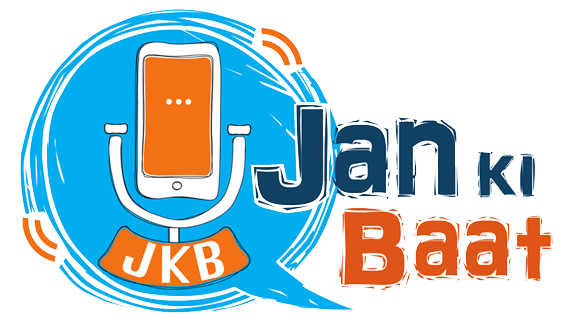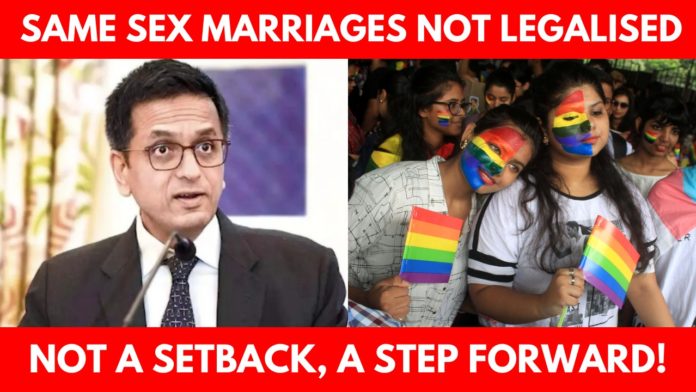Sagarika Mitra, Content Head of JAN KI BAAT, decodes the judgement in this article
In a significant ruling, the Supreme Court of India has refused to recognize same-sex marriages, asserting that this matter falls within the domain of the legislature. However, the court’s verdict is far from a setback for the LGBTQIA+ community. Instead, it marks a pivotal step toward recognising their rights and equality under the law.
Highlights:
Supreme Court of India refrains from granting legal recognition to same-sex marriages.
However, the unanimous consensus among the judges on the bench has led to a groundbreaking directive for the Union of India.
While the court did not alter the legal definition of marriage, it has opened a significant avenue for change by directing the government to establish a committee
This committee’s mission is to explore and define the rights and entitlements of individuals in queer unions, marking a promising step toward acknowledging and protecting the rights of the LGBTQIA+ community in India.
The Judiciary’s Cautious Approach
The five-judge bench, led by Chief Justice of India DY Chandrachud and comprising Justices Sanjay Kishan Kaul, S Ravindra Bhat, Hima Kohli, and PS Narasimha, carefully navigated the complex issue involving same-sex marriages. While declining to strike down the Special Marriage Act and the Foreign Marriage Act for not recognising queer marriages, the court has given clear directions to protect and affirm the rights of the LGBTQIA+ community.
‘It’s the first step towards a long battle in the battle for equal rights for LGBTQIA+ community’, says Tahira Karanjawala, Partner at Karanjawala & Co and Petitioner in the case
CJI Chandrachud’s Progressive Directions:
Chief Justice DY Chandrachud outlined a series of directions aimed at ending discrimination and ensuring the protection of queer individuals and couples. The key takeaways from his directions are:
A. Non-Discrimination: The Union Government, State Governments, and Union Territories are directed to ensure that the queer community is not discriminated against. This extends to non-discrimination in access to goods and services.
B. Public Sensitisation: Public awareness about queer rights is emphasized, aiming to reduce prejudice and enhance understanding.
C. Support Services: Creating hotlines and safe houses for queer couples ensures they have a support system in place.
D. Against forced medical interventions: The court has taken a firm stance against the forced medical interventions on intersex children.
E. No Forced Hormonal Therapy: The judgment explicitly prohibits any forced hormonal therapy on queer individuals.
F. Preventing Harassment: The court underlines that queer individuals should not be summoned to police stations solely for inquiries about their sexual identity.
G. No Forced Family Return: The police are barred from compelling queer persons to return to their natal family
H. Preliminary Enquiry: Law enforcement agencies should conduct a preliminary inquiry before registering an FIR against a queer couple over their relationship.
Understanding the Judgment:
Supreme Court’s decision is best understood as a cautious step that respects the boundaries of the legislature while guiding it toward a more inclusive and equitable approach to same-sex unions. The court acknowledges the complexities of altering existing legislation, such as the Special Marriage Act, and refrains from overstepping into the realm of lawmaking.
‘A Natural Phenomenon’
CJI Chandrachud emphasizes that being queer is not an urban or elitist concept but rather a natural phenomenon that has existed in India for ages. This recognition dispels notions that same-sex relationships are a foreign import and underscores their indigenous presence.
The Fight Against Discrimination
The court’s ruling underscores that the failure of the State to recognise the rights stemming from a queer relationship amounts to discrimination. It asserts that the right to enter into a ‘union’ cannot be restricted based on sexual orientation. The court’s directions are a clear statement against discrimination and in favor of equal treatment under the law.
Positive Steps Towards Equality
The Supreme Court’s decision, while cautious in terms of legislative boundaries, is undeniably a step in the right direction for LGBTQIA+ rights in India. By tasking the government with constituting a committee to examine the rights and benefits that can be granted to queer couples, the court has effectively nudged the legislature to take action.
Moreover, the court’s acknowledgment that unmarried couples, including queer couples, can jointly adopt a child signifies a broader recognition of the LGBTQIA+ community’s role in family life.
Implications and the Way Forward
The Supreme Court’s ruling, while not recognizing same-sex marriages, does not foreclose the possibility of change in the future. It offers a roadmap for progress by directing the government to constitute a committee to examine the rights and entitlements of individuals in same-sex unions. This committee’s mandate encompasses a broad range of considerations, from including queer couples in ration cards to enabling joint bank accounts, as well as addressing rights related to pension and gratuity benefits.
The court’s directive places the spotlight on the parliament, urging lawmakers to act in accordance with constitutional principles and global trends in recognizing LGBTQIA+ rights. This verdict is a step forward in the ongoing struggle for equal rights for the LGBTQIA+ community in India, even if it stops short of redefining marriage laws. It sends a strong signal that change is on the horizon and underscores the necessity of addressing the rights of same-sex couples.
The ball is now in the legislature’s court, and the nation watches with anticipation for a future where same-sex marriages are legally recognised in India.

